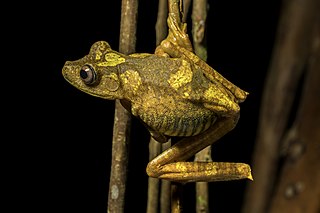Oreophrynella weiassipuensis is a species of toads in the family Bufonidae. It is only known from Wei-Assipu-tepui, a tepui on the border between Brazil and Guyana. The holotype was collected in 2000 by a speleological expedition to Wei-Assipu-tepui. No other specimens are known. It is possible that it is present in other localities, but most species of Oreophrynella are endemic to a single mountain.
Vitreorana gorzulae is a species of frog in the family Centrolenidae. It is found in Bolívar state in Venezuela and in Guyana. In Spanish it is known as ranita de cristal de Gorzula. Its natural habitats are subtropical or tropical moist montane forests, rivers, and intermittent rivers.
Vitreorana helenae is a species of frog in the family Centrolenidae. Two common names are sometimes used to refer to this species: Venezuelan glass frog and Helena's glass frog. In Spanish, it is locally known as ranita de cristal de Helena.
Warren's tree frog is a species of frog in the family Hylidae found in Guyana and possibly Brazil and Venezuela. Its natural habitats are subtropical or tropical moist montane forests, rivers, freshwater marshes, and intermittent freshwater marshes.

The map tree frog is a species of frog in the family Hylidae found in Bolivia, Brazil, Colombia, Ecuador, French Guiana, Guyana, Peru, Suriname, Trinidad and Tobago, and Venezuela. Its natural habitats are subtropical or tropical dry forests, subtropical or tropical moist lowland forests, moist savanna, subtropical or tropical seasonally wet or flooded lowland grassland, rivers, freshwater lakes, intermittent freshwater lakes, freshwater marshes, plantations, rural gardens, heavily degraded former forests, ponds, and aquaculture ponds. It was previously known as Hyla geographica. The name comes from the reticulated map-like patterns on its eyelids (palpebrum). The black tadpoles congregate in dense clusters in ponds or other calm waters.
The Lema tree frog is a species of frog in the family Hylidae found in Guyana, Venezuela, and possibly Brazil. Its natural habitats are subtropical or tropical moist lowland forests, subtropical or tropical moist montane forests, rivers, pastureland, rural gardens, heavily degraded former forests, aquaculture ponds, and canals and ditches. It is threatened by habitat loss.
Hoogmoed's tree frog is a species of frog in the family Hylidae found in Guyana, possibly Brazil, and possibly Venezuela. Its natural habitats are subtropical or tropical moist montane forests and rivers.
The La Escalera tree frog is a species of frog in the family Hylidae found in Guyana, Venezuela, and possibly Brazil. Its natural habitats are subtropical or tropical moist lowland forests, subtropical or tropical moist montane forests, rivers, and freshwater marshes.

The Manaus slender-legged tree frog, also known as the giant broad-headed tree frog, is a species of frog in the family Hylidae found in Bolivia, Brazil, Colombia, Ecuador, French Guiana, Guyana, Peru, Suriname, and Venezuela. Its natural habitats are subtropical or tropical dry forest, subtropical or tropical moist lowland forest, moist savanna, rivers, intermittent freshwater marshes, and canals and ditches. It is threatened by habitat loss. It is also reported to produce bufotenin.

Adenomera andreae is a species of frog in the family Leptodactylidae.
Stefania ackawaio is a species of frog in the family Hemiphractidae. It is endemic to Guyana. Its natural habitat is subtropical or tropical moist montane forests.
Stefania ayangannae is a species of frog in the family Hemiphractidae. It is endemic to Guyana where it is known from Mount Ayanganna and Mount Wokomung, both in the Pacaraima Mountains.
Stefania coxi is a species of frog in the family Hemiphractidae. It is endemic to Guyana and has been found on Mount Ayanganna and Mount Wokomung. Its natural habitat is subtropical or tropical moist montane forests at higher elevations.

Stefania evansi is a species of frog in the family Hemiphractidae. Stefania evansi is, along with other closely related frogs, known for its unusual reproductive mode where females carry the eggs and juveniles on their back. It is sometimes known under common names Groete Creek carrying frog, Groete Creek treefrog, or Evans' stefania. These names refer to its type locality, Groete Creek in the region Essequibo Islands-West Demerara, Guyana, where the holotype was collected by one Dr. R. Evans.
Stefania roraimae is a species of frog in the family Hemiphractidae. It is endemic to Guyana. Its type locality is Mount Roraima; it is also known from Mount Ayanganna and Mount Wokomung. It presumably occurs in the adjacent Venezuela and Brazil too.
Stefania woodleyi is a species of frog in the family Hemiphractidae. It is endemic to the eastern part of the Pakaraima Mountains in Guyana, including Mount Wokomung and Mount Ayanganna.
Otophryne robusta is a species of frog in the family Microhylidae. It is found in Guyana, Venezuela, and possibly Brazil. Its natural habitats are tropical moist montane forests and rivers. It is threatened by habitat loss.
Otophryne steyermarki is a species of frog in the family Microhylidae. It is found in western Guyana and in the Bolívar state in eastern Venezuela.
The Arrabal's Suriname toad is a species of frog in the family Pipidae found in Brazil, Guyana, Suriname, Venezuela, and possibly Peru. Its natural habitats are subtropical or tropical moist lowland forests, freshwater marshes, intermittent freshwater marshes, ponds, and canals and ditches. It is threatened by habitat loss.
Rhinatrema nigrum, the black caecilian, is a species of caecilian in the family Rhinatrematidae found in Guyana, Venezuela, and possibly Brazil. Its natural habitats are subtropical or tropical moist lowland forests, subtropical or tropical moist montane forests, rivers, and intermittent rivers.




